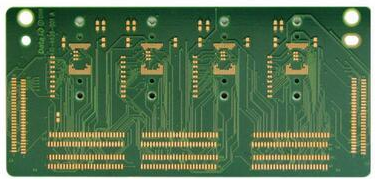multilayer soft board etching, resist stripping-double-sided FPC manufacturing process: Many of the process conditions described above are prepared for etching, but the process conditions of etching itself are also very important.
The etching machine is somewhat similar to the developing machine, but there is a resist stripping device behind the etching machine. The etching process is not exactly the same as the wet treatment process mentioned above. During the etching process, the mechanical strength of the flexible printed board will change greatly. This is because most of the copper foil is etched away, so it is softer, so it is designed for Special attention should be paid to this when etching machines for flexible printed boards. A reliable assembly line for flexible printed circuit board manufacturing means that the etched flexible board must be able to be transported smoothly without a guide pull board.
When considering the etching of precise patterns, attention should be paid to the etching device and other process conditions, and the original image should be compensated and corrected according to the etching coefficient.

That is, all the process conditions are the same, and the etching coefficients of the parts with high line density and the parts with low line density are also different. Compared with the parts with large line spacing, the parts with small line spacing have poor exchange of new and old etching solutions, so the etching speed is slow. For circuits with the same design width, if the circuit density is different in the same board, the wires in the high-density area may not be etched and separated during etching, and the circuits in the low-density area may be deformed due to side erosion. Thin or even broken wires, it is difficult to solve this situation completely relying on etching equipment and etching process conditions.
In order to solve this problem, the etching coefficient can be obtained by experimenting with each line density in advance, and compensation and correction can be made when the original image is made. For precision lines with large densities, the actual etching process must be performed and the etching conditions can be corrected. Sometimes Need to go through 2 to 3 corrections. Although this is trivial, it is very important to ensure the etching accuracy and stable process of high-density circuits. From the perspective of improving material utilization, the smaller the width between the plate and the graphics, the better, but for stable transmission, the edge width of the plate should be as wide as possible, and the interval between the impositions should also be larger.
From the above description, it can be seen that there are many factors that affect the etching property of the circuit. Any project is not a separate process, but a process of mutual coordination and complicated relationship. To carry out high-precision precision circuit etching and obtain satisfactory results, it is necessary to continuously accumulate data on these factors affecting etching in the daily FPC production process.